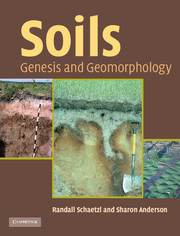Book contents
- Frontmatter
- Contents
- Preface
- Acknowledgements
- Part I The building blocks of the soil
- Part II Soil genesis: from parent material to soil
- 8 Soil parent materials
- 9 Weathering
- 10 Pedoturbation
- 11 Models and concepts of soil formation
- 12 Soil genesis and profile differentiation
- Part III Soil geomorphology
- References
- Glossary
- Index
11 - Models and concepts of soil formation
from Part II - Soil genesis: from parent material to soil
- Frontmatter
- Contents
- Preface
- Acknowledgements
- Part I The building blocks of the soil
- Part II Soil genesis: from parent material to soil
- 8 Soil parent materials
- 9 Weathering
- 10 Pedoturbation
- 11 Models and concepts of soil formation
- 12 Soil genesis and profile differentiation
- Part III Soil geomorphology
- References
- Glossary
- Index
Summary
Soils are very complex natural phenomena. They exist at the interface of the lithosphere, atmosphere and biosphere, and perform vital functions within the hydrologic cycle. They inherit, react to and impact (seemingly simultaneously) spatial and temporal variability from all three of these realms. Erosion, burial, climate change, biomechanical movement and mixing processes, water table effects, inputs of eolian dust, microclimatic effects of aspect and topography, and innumerable other nuances of the soil-forming environment all interact to form the most complex of natural systems. To top it off, there is no agreed-on endpoint toward which the soils are developing; there is no equifinality. Earth's soils are each on their own individual journey, to an end that may be impossible to envision or obtain.
How can one possibly make sense of this noise and sensory overload? By using conceptual models which help us understand the soil system and soil formation and distinguish a signal from all the noise. Conceptual models are essential tools of science; they are simplified descriptions of natural systems. Rather than being precise mathematical descriptions that can be solved, given ample data, they are used to help put soils information into perspective and provide insight into the system interrelationships, process linkages and the nuances of pedogenesis and soil geomorphology (Dijkerman 1974). They are a way to organize, simplify and enumerate the factors that affect soil systems or the processes occurring in those systems (Smeck et al. 1983).
- Type
- Chapter
- Information
- SoilsGenesis and Geomorphology, pp. 295 - 346Publisher: Cambridge University PressPrint publication year: 2005
- 1
- Cited by



